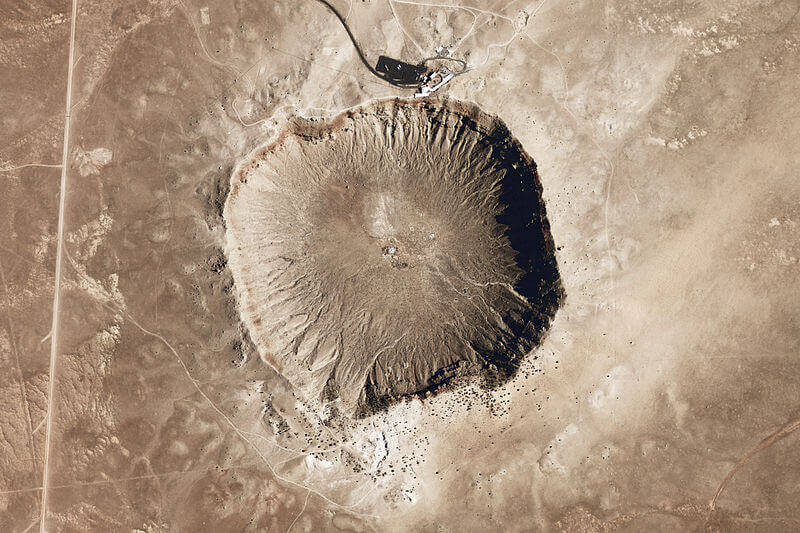"It's super exciting. It doesn't happen too often."

National Map Seamless Server (USGS)An example of an asteroid impact crater in Arizona, which was made 50,000 years ago.
Recently, a curious camper was scouting out his next campsite in Quebec’s Côte-Nord region on Google Maps when he discovered a bizarre pit in the Earth resembling an impact crater.
These craters form when meteorites and other space rocks crash into Earth at thousands of miles per hour, melting and recrystallizing rocks.
Scientists conducted preliminary tests on minerals at the Canadian site and they believe it could be a potential meteorite impact crater.
Now, a research team plans to explore the site next year and determine once and for all whether the area is an impact crater. If so, it would be Quebec’s 11th known impact crater and Canada’s 32nd.
How A Canadian Camper Found A Possible Meteorite Impact Crater On Google Maps

Gordon OsinskiThe possible ancient impact crater near Magpie, Quebec.
Joël Lapointe was scoping out a potential campsite in Quebec’s Côte-Nord region while using Google Maps when he discovered something unusual.
In the image, Lapointe saw a nine-mile-diameter pit with a strange curve. Nearby was a ring of small mountains surrounding Marsal Lake.
The striking topography prompted Lapointe to contact scientists. Pierre Rochette, a geophysicist with the Centre de Recherche en Géosciences de l’Environnement in Aix-en-Provence, France, reviewed the image and agreed that it was “very suggestive of impact,” according to the CBC.
Rochette has since presented his findings at the Annual Meeting of the Meteoritical Society in Brussels, Belgium. During his presentation, Rochette pointed out the unusual features of the site in Côte-Nord. “Based on the already available preliminary evidence,” his team explained, according to Popular Mechanics, “Lake Marsal seems to be a serious candidate to become the 11th confirmed impact structure from Quebec.”
Another scientist, Gordon Osinski from Western University in Ontario, Canada, also took an interest in the findings. Osinski stated that a tell-tale sign of a crater impact is the presence of shatter cones, which are specific types of grooves or lines on the surfaces of rocks.
“Those are essentially unequivocal evidence of meteorite impact,” Osinski explained in an interview with the CBC.

Gordon OsinskiGordon Osinski at the Haughton impact structure in Nunavut, Canada, where he has conducted past research.
Rochette, alongside Osinski and other researchers, formed a preliminary team to examine and hopefully explore the Côte-Nord site in 2025.
Scientists Are Collaborating To Get To The Bottom Of The Quebec Crater Question
Initial research into the potential impact crater has already begun in France. Pierre Rochette and his team received samples from the site and have started to analyze them for signs of a meteorite impact.
So far, Rochette has identified zircon, a mineral that often forms after a big impact event. This finding strongly supports the idea that the site experienced a meteorite event, but it is not conclusive at this point.

Gavin Kenny/Trinity College DublinAn example of a zircon crystal from the Sudbury impact crater in Ontario.
Gordon Osinski notes that the findings are not a “smoking gun” yet.
“It’s quite easy with Google Earth these days to go on and find structures that are circular or semi-circular in origin. You know, nine times out of 10 they’re not [craters],” Osinski explained to the CBC.
However, Osinski aims to join the French research team in 2025 and travel to the site to collect more samples and conduct more tests.
If the Marsal Lake site is proven to be legitimate, it would be the first discovery of an impact crater this size since 2013.
“It’s super exciting,” Osinski said. “It doesn’t happen too often.”
Hopefully, the research team can carry out a more extensive study of the Côte-Nord site next year and provide conclusive findings.
After reading about the potential meteorite impact crater in Quebec, dive into the story of the Gates of Hell, Turkmenistan’s gas crater that has been on fire since the 1970s. Then, learn about the unsolved mystery of the Carancas Meteorite Sickness that plagued residents in a remote Peruvian village after a meteorite crashed nearby in 2007.





